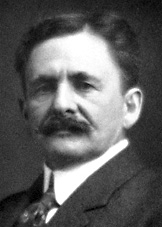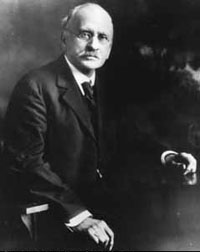Albert A. Micheleson & Edward W. Morley
Created by Adrienne Dooley
In 1887, Albert A. Micheleson and Edward W. Morley performed what is now considered one of the most famous failed experiments.
Personal Life
Albert A. Micheleson

Albert A. Micheleson was born on December 19, 1852 in Strelno, Prussia. Following high school graduation he was appointed to the United States Naval Academy by President Grant. After a two-year cruise in the West Indies he taught physics and chemistry at the United States Naval Academy. After leaving the military, he continued his educations, studying at the Universities of Berlin and Heidelberg, and the College de France and Ecole Polytechnique in Paris. In 1883, he accepted a position as Professor of Physics at the Case School of Applied Science in Cleveland, Ohio, where he performed the Micheleson-Morley experiment. In 881 he invented the interferometer to discover the effect of the Earth's motion on the observed velocity, used in the Micheleson-Morley experiment and allowed for greater accuracy in measuring distances using the length of light-waves. Following his employment at Case, he taught physics at both Clark University and the University of Chicago, becoming the Head of Department at the later. In 1907 he was the first American to win a Nobel prize in science, winning the Nobel Prize in Physics for his studies on the velocity of light. He rejoined the Navy from 1918-1929, resigning to work at the Mount Wilson Observatory in Pasadena, California. Micheleson was president of the American Physical Society (1900), the American Association for the Advancement of Science (1910-1911), and the National Academy of Sciences (1923-1927). He received many awards throughout his career, including the Matteucci Medal from the Societa Italiana in 1904, the Copley Medal from the Royal Society in 1907, the Elliot Cresson Medal from the Franklin Institute in 1916, the Medal of the Royal Astronomical Society in 1923, and the Duddel Medal from the Physical Society in 1929. Some of his most famous published works include Velocity of Light in 1902, Light Waves and Their Users in 1899, and Studies in Optics in 1927. Micheleson also measured the diameter of the star Betelgeuse - the first accurate determination of the size of a star. He married Edna Stanton of Lake Forest, Illinois in 1899. The couple had four children.
Edward W. Morley

Edward W. Morley was born January 29, 1838 in Neward, New Jersey and was raised on Connecticut and Massachusetts. He was graduated from Williams College in 1860. He began his career with the ministry and worked in the United States Sanitary Commission and taught eleven different subjects at the South Berkshire Institute. He earned honorary masters and doctorate degrees from Cleveland Medical Colleges and Wooster College respectively. He accepted a position as Instructor of Chemistry, Geology, Natural History, and Mathematics at Western Reserve College in Hudson, Ohio and in 1869, following a Congregational pastorate in Ohio. He remained as an emeritus professor until 1906. Between 1873 and 1888 Morley also taught at the Cleveland Medical School. Aside from the Micheleson-Morley experiment, he worked researched the determination of molecular weights using "wet chemistry." His research on the atomic weight of oxygen provided a new standard for chemistry and to this date the accuracy of his analysis has not been superseded by chemical means. He published his value for the relative atomic weight of oxygen as 15.879, with the scale of hydrogen equal to 1, in 1895 in the Smithsonian Institution Contributions to Knowledge no. 980. He was president of both the American Chemical Society (1899-1900) and the American Association for the Advancement of Science (1896) as well as named to the National Academy of Sciences and the American Academy of Arts and Sciences. He was also made an honorary member of the Royal Institution, the Chemical Society of London, and the British Association for the Advancement of Science. Morley published fifty-six scientific papers throughout his career. In 1907 he received the Davy Medal of the Royal Society. He was married to Isabella Birdsall.
Miceleson-Morley Experiment
Background
In the 19th century, scientists believed in the existence of a luminiferous ether, a medium in which light waves could flow through across the Earth's surface. This belief come from the fact that other waves, such as water waves and sound, must move across a medium, water and air respectively. There must, therefore, be a medium between the earth and the sun that was transparent (not readily observable). Assumptions of this ether include that it was stationary and that it filled all of space. In 1887, Micheleson and Morley set up an experiment to prove that an ether existed and to understand its motion relative to the Earth.
Experimental Set-Up
Results
The null result was used to justify Albert Einstein's Theory of Relativity.
Connectedness
- How is this topic connected to something that you are interested in?
- How is it connected to your major?
- Is there an interesting industrial application?
History
Put this idea in historical context. Give the reader the Who, What, When, Where, and Why.
See also
Are there related topics or categories in this wiki resource for the curious reader to explore? How does this topic fit into that context?
Further reading
Books, Articles or other print media on this topic
External links
References
This section contains the the references you used while writing this page